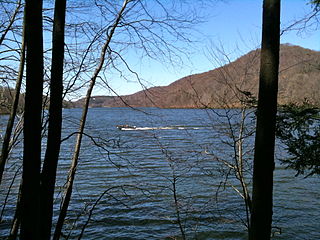
Southbury is a town in western New Haven County, Connecticut, United States. Southbury is north of Oxford and Newtown, and east of Brookfield. Its population was 19,879 at the 2020 census. The town is part of the Naugatuck Valley Planning Region.
The Potatuck were a Native American tribe in Connecticut. They were related to the Paugussett people, historically located during and prior to the colonial era in western Connecticut. They lived in what is now Newtown, Woodbury and Southbury of Fairfield County, and along the whole Housatonic River, including the Schaghticoke tribe. One of their last sites of habitation, Little Pootatuck Brook Archeological Site, is listed on the National Register of Historic Places. After losses due to epidemics and warfare, they merged in the early 18th century with other remnant Native American groups in the area, forming the Schaghticoke tribe.
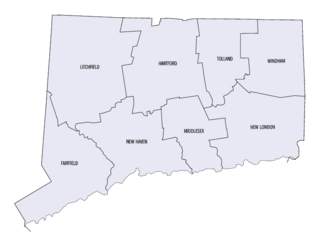
This is a list of properties and districts listed on the National Register of Historic Places in Connecticut. There are more than 1,500 listed sites in Connecticut. All 8 counties in Connecticut have listings on the National Register.

Hubbard Park, located in the Hanging Hills of Connecticut, is a wooded, mountainous park located just outside the city center of Meriden, Connecticut. It comprises approximately 1,800 acres (7.3 km2) of carefully kept woodlands, streams, dramatic cliff faces, flower gardens, and the James Barry bandshell and picnic spots, as well as its showpiece, Mirror Lake. The park is listed on the National Register of Historic Places.

Windsor station is a historic railroad station on Amtrak's New Haven–Springfield Line, located in downtown Windsor, Connecticut. It is served by Amtrak Northeast Regional and Valley Flyer intercity service and CT Rail's Hartford Line commuter rail service. The nearby Hartford & New Haven Railroad-Freight Depot serves as the home of the Windsor Arts Center.

This is a list of properties on the National Register of Historic Places in Hartford, Connecticut.
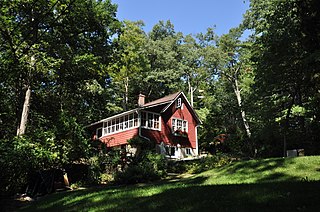
The Russian Village Historic District, also known as Churaevka, is a historic summer colony founded by George Grebenstchikoff and Ilya Tolstoy in Southbury, Connecticut. The colony was founded in the 1920s by Russian emigres, and retains distinctive Russian touches in the architecture of its houses, as well as a small chapel designed by Nicholas Roerich. The colony was listed on the National Register of Historic Places in 1988.
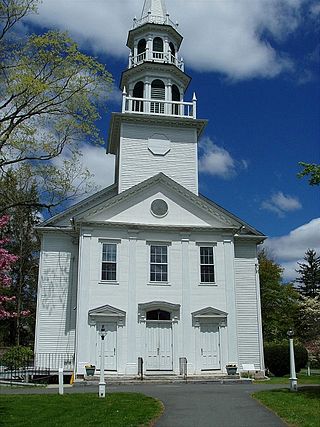
The South Britain Historic District encompasses the core of the unincorporated village of South Britain in Southbury, Connecticut, United States. The village arose in the 18th century as an industrial center serving the surrounding agricultural community, powered by the Pomperaug River, and rivalled the town center of Southbury in importance. The district was listed on the National Register of Historic Places in 1987.

The Zoar Trail is a 6.5-mile (10.5 km) Blue-Blazed hiking trail "system" in the lower Housatonic River valley in Fairfield County and is entirely in the Sandy Hook section of Newtown in the lower block of Paugussett State Forest.
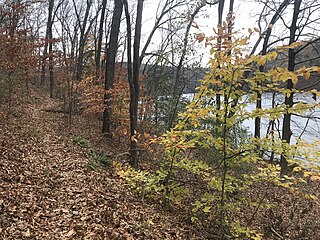
The Kettletown Trails are a 4.6-mile (7.4 km) Blue-Blazed hiking trail "system" in the lower Housatonic River valley in Fairfield County and are in the towns of Southbury and Oxford -- primarily in the Kettletown State Park and the Jackson Cove recreation area belonging to the town of Oxford.

The Josiah Bronson House is a historic house on Breakneck Hill Road in Middlebury, Connecticut, built about 1738. It is one of the town's few surviving 18th-century houses, and a good example of residential architecture from that period. It was listed on the National Register of Historic Places in 1982.

Lake Zoar is a reservoir on the Housatonic River in the U.S. state of Connecticut. It was formed by the completion of the Stevenson Dam, which flooded an area of Oxford and Stevenson named "Pleasantvale" or "Pleasant Vale". "Connecticut's Lakes Reflect Our History, Present". Retrieved 2018-04-02. The towns of Monroe, Newtown, Oxford, and Southbury border Lake Zoar. The name Zoar originates from corner of Newtown and Monroe that once called itself Zoar after the Biblical city Zoara near the Dead Sea.
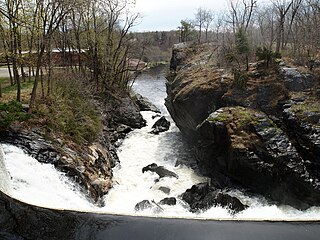
The Commonwealth Works Site is an historic industrial archaeological site in Norwich, Connecticut. Located near the Yantic Falls on the Yantic River, it was the site of a major industrial facility developed in the mid-19th century, with an industrial history dating back to the 18th century. Charles Augustus Converse had consolidated water rights at the falls, and built a large complex which housed a number of different water-powered enterprises, including the gun factory of Ethan Allen, a gristmill, sawmill, woolen mill, nail factory, and a cork-cutting factory.

The Hammonasset Paper Mill Site is a historic industrial archaeological site off Green Hill Road in Killingworth and Madison, Connecticut. The site contains the remains of a paper mill built in 1865 and operated until 1890. The site, listed on the National Register of Historic Places in 1996, is owned by a local land trust, and is accessible by hiking trails.
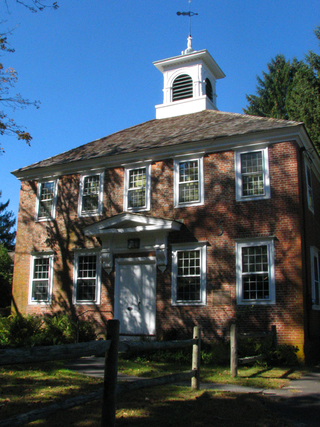
The Bullet Hill School is a historic school building on Main Street in Southbury, Connecticut. Built in the last decade of the 18th century, it is one of the oldest brick school buildings in the state of Connecticut. It was listed on the National Register of Historic Places in 1972.

The Reuben Curtiss House is a historic house at 1770 Bucks Hill Road in Southbury, Connecticut, United States. With a construction and alteration history dating from the late 18th to 20th centuries, the house is one of Southbury's finest examples of residential Greek Revival architecture. It was listed on the National Register of Historic Places in 1993.

The William Hurd House is a historic house at 327 Hulls Hill Road in Southbury, Connecticut. Built in the late 18th century and enlarged about 1820, it is a good local example of Federal period architecture, with well-preserved outbuildings. It was listed on the National Register of Historic Places in 1993.

The Hurley Road Historic District encompasses a pair of rural 19th-century properties built by members of a single family at 6 and 17 Hurley Road in Southbury, Connecticut. Included are Federal and Greek Revival houses, and a number of outbuildings, giving the cluster a distinct period feel. The area was listed on the National Register of Historic Places in 1993.

The Southbury Historic District No. 1 encompasses a well-preserved 19th-century village landscape along Main Street North in Southbury, Connecticut. This area includes the historic town center of Southbury, and is part of a larger streetscape extending into neighboring Woodbury, where it continues in the Woodbury Historic District No. 2. The district was listed on the National Register of Historic Places in 1971.








